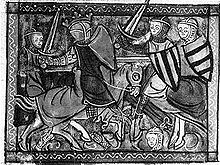Henry of Castile
Heinrich (Enrique), Infante of Castile , called El Senador , (* March 1230 ; † August 1304 ) was a younger son of Ferdinand III. , the saint, King of Castile and his first wife Beatrix of Swabia , a daughter of the Roman-German King Philip of Swabia . Heinrich made a hero name for himself during the conquest of Seville in 1248 when he successfully defended the army with a few men against a strong Moorish superiority. In gratitude, his father Ferdinand gave him large estates in Andalusia.
After the death of his father in 1252 conflicts arose between him and his brother Fadrique on the one hand and the eldest brother Alfonso , who took over the reign , who claimed their possessions. Heinrich conspired with his stepmother and started an uprising in the southwest in October 1255. Despite an initial victory over the royal troops, he was defeated near Morón and had to leave the country. Heinrich sought refuge with his stepmother in Ponthieu. She may have advised him to visit his half-sister Eleanor of Castile , who was married to Edward I (son of Henry III ).
Heinrich arrived at the English court in August 1256. He lived there for three years while diplomatic relations with Castile deteriorated. Henry III. asked him to leave the English court. Heinrich therefore first set out for Valencia in 1259, where he competed for the hand of Princess Constance of Aragon. In order to do his bit for them, he conquered the Moorish kingdom of Niebla in the Algarve. His brother Alfonso X sent his army against him. Heinrich, however, defeated its leader, Nuno Gonzalez de Lara in a knightly duel, and then had to sail towards Africa, and became a mercenary with the Emir al-Mustansir in Tunis, where he met his combative brother Fadrique. He later moved to Italy, where in 1266 he helped his cousin Charles I of Anjou to ascend the throne of Sicily after the battle of Benevento against Manfred von Hohenstaufen . He borrowed large sums of money from his cousin. The captain of the people (Capitano del Poppolo) Angelo Capocci, leader of the People's Party, appointed Henry of Castile Senator of Rome, which explains his nickname "El Senador". Since Charles I of Anjou could not repay the borrowed sums of money, he should have given Henry the title of King of Sardinia. Meanwhile, he broke his word of honor. That is why, when Heinrich's cousin Konradin von Hohenstaufen invaded Italy in 1268 as the legal heir of Sicily, the senator in Rome received him with all honors and allied himself with him, together with an army of Ghibelin supporters from many cities in Italy. Heinrich was one of the bravest generals in the battle of Tagliacozzo . After the defeat, he fled to the convent of San Salvatore, where he was captured by the Angevines. He spent the next 23 years in captivity in Naples (Canosa di Puglia and Castel del Monte). In 1272 his half-sister Eleanor of Castile and her husband, King Edward I , who were returning from the crusade in Tunis, made a stopover in Sicily. Eleanor of Castile tried to free her half-brother, but she was unsuccessful. But she stayed in touch with him until her death.
Eleanor of Castile and Charles I of Anjou died before Henry was released in 1291. He then went to Tunis to see King Abou Hafs, with whom he had earlier conquered Miliana in Algeria. He returned in 1294 as ambassador from Tunis to Aragon, and later to Castile, where he was appointed regent in place of his great-nephew, King Ferdinand IV. He fought on the battlefield against the Moors of Granada for the last time in 1295. He married a lady of the Lara family but probably had no children with her. He died in 1304. He had descendants from a love affair in his youth with a woman of the nobility by the name of Mayor Rodriguez Pecha. His grandson was Enrique Henríquez de Sevilla, high official under King Alfonso XI of Castile. The life story of Henry of Castile, his skills as a poet, his war experiences in England and on the Mediterranean Sea, and temporal coincidences have given cause to determine him as the author and author of the famous knight tale Amadis de Gaula , which appeared around the year 1300 . This theory is represented in a number of writings in Liceus El Portal de las Humanidades by Santiago Seville.
literature
- Antonio Ballesteros Beretta, Deborah Kirschberg Schenck: Sevilla en el siglo XIII. Instituto de la Cultura y las Artes, 2007, ISBN 8-496-09893-1 .
- John Carmi Parsons: Eleanor of Castile. Queen and Society in Thirteenth Century England. Palgrave Macmillan, 1997, ISBN 0-312-17297-4 .
- Steven Runciman: The Sicilian Vespers. Cambridge University Press, 1958. ISBN 0-521-43774-1 .
- Peter Herde: The battle at Tagliacozzo in the magazine for Bavarian national history (ZBLG) 1962
- Valeria Bertolucci Pizzorusso Università di Pisa Don Enrique-Don Arrigo: un infante di Castiglia tra storia e letteratura- Alcanate Revista de Estudios Alfonsíes Volume IV 2004-2005 Puerto de Santa María
| personal data | |
|---|---|
| SURNAME | Henry of Castile |
| ALTERNATIVE NAMES | El Senador |
| BRIEF DESCRIPTION | Prince of Castile |
| DATE OF BIRTH | March 1230 |
| DATE OF DEATH | August 1304 |
